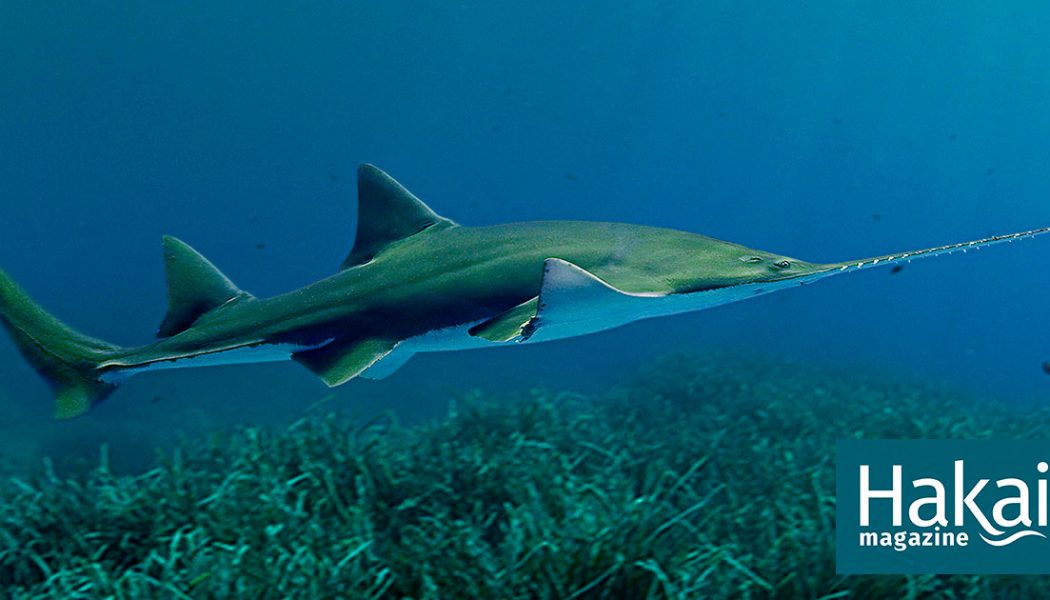
Article body copy
New research conducted in Tanzania is providing a chilling example of shifting baselines: the idea that how much an ecosystem appears to have changed depends on when one starts paying attention. Through a series of interviews with Tanzanian fishers, people who spend nearly every day out on the water, scientists found a troubling trend: while all of the older fishers could recognize sawfish, only a handful of young fishers had even heard of these amazing and endangered fish. The research, led by Gill Braulik, a marine ecologist at the University of St Andrews in Scotland, in collaboration with Tanzanian scientists, suggests that sawfish have nearly completely disappeared from Tanzanian waters in just a few decades.
Sawfish are among the most endangered marine fishes in the world. The sawblade-like rostrum of these shark-like rays gets easily tangled in fishing gear, and by-catch has become an existential threat for the five sawfish species that were once common across a large chunk of the world. Habitat destruction, too, is a major impediment to sawfish survival—all five species are now considered endangered or critically endangered by the International Union for Conservation of Nature. But as with any environmental issue, getting people to change their behavior to help solve a problem is difficult if they don’t even know a problem exists. And if people grow up in a world without a species in it, they may not realize what they’re missing.
“We don’t even really know what to restore because [almost] nobody is alive who remembers what has been lost,” says Braulik. “The environment is changing so fast that humans are losing the knowledge of what it used to be like. These results are a reminder of how incredibly abundant and diverse the Tanzanian oceans must have been, but now they are so depleted. None of us can envision what the world was like before it became so changed by humans.”
Though the near-total loss of a large animal within one human life span is alarming, it’s perhaps not surprising given what we know about global sawfish declines. These animals used to be found in 90 countries, but nearly half have lost at least one species. And this isn’t just a problem in developing nations like Tanzania.
“This is a reality being experienced throughout the world as sawfishes are becoming locally extinct in many countries,” says Tonya Wiley, the president of the sawfish science and conservation organization Havenworth Coastal Conservation, who was not involved in this study.
Wiley says smalltooth sawfish used to be found from New York to Texas and are now restricted to a small part of South Florida. “During my outreach events people often tell me they have fished or dived in Florida all their lives and never seen a sawfish,” she says.
Braulik says interviewing Tanzanian fishers has offered otherwise inaccessible information about the troubled species. “When trying to gather information about very rare species, it might take months or years of fieldwork to ever encounter even one animal,” says Braulik. “A much better way to gather information is to talk to people who work and live their entire lives on the sea.”
Older fishers, in particular, “have a wealth of knowledge about the ocean going back decades,” she says. They “remember how the ocean used to be and can describe the changes.”
Though the study mostly chronicled loss, it also identified a cause for hope: one fisher reported that he regularly caught baby sawfish, an important revelation that the team immediately followed up on.
“We were a bit skeptical and thought perhaps it was something else,” Braulik says. But the fisher took the researchers to his fishing shack and showed them the saw from a baby fish. “This means that the waters near his village may well be a nursery area, and as these are quite rare discoveries, especially in East Africa, this is important information to try and protect the last remaining holdout for sawfish in Tanzania.”









